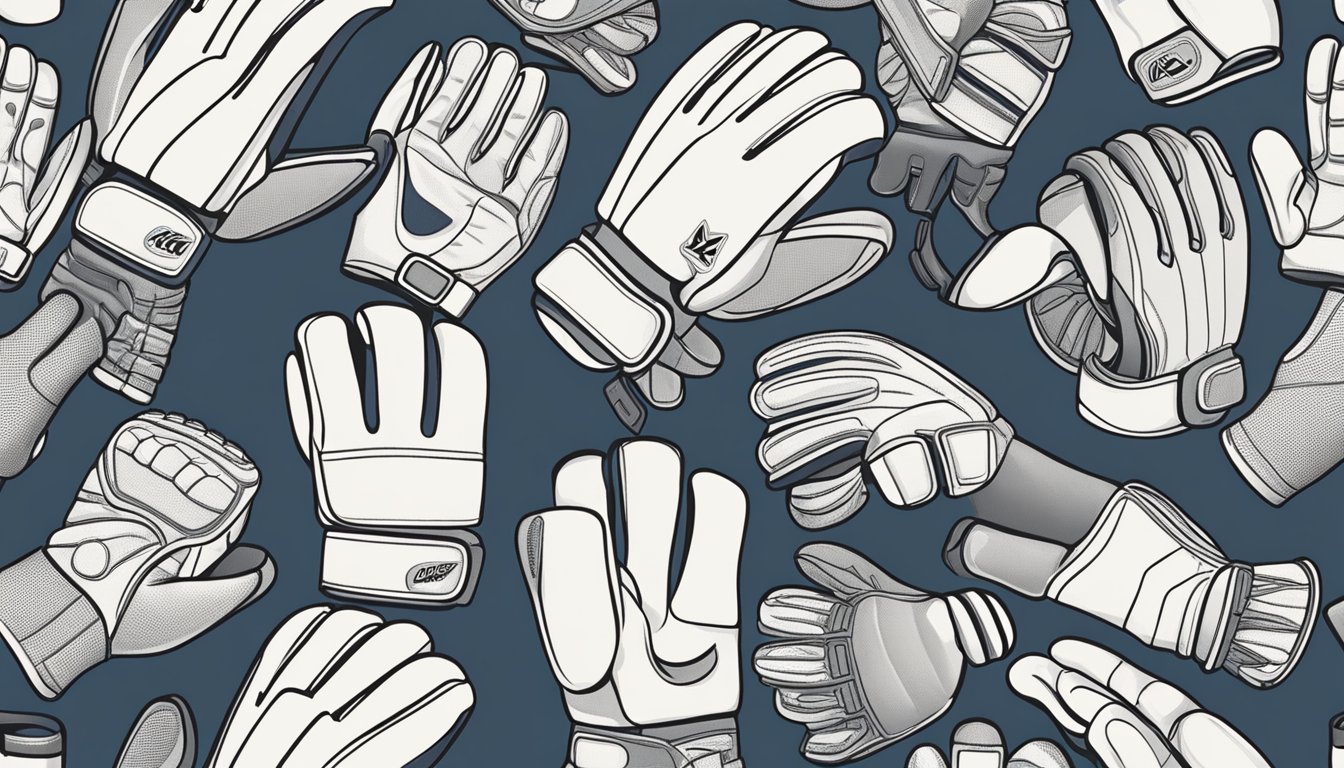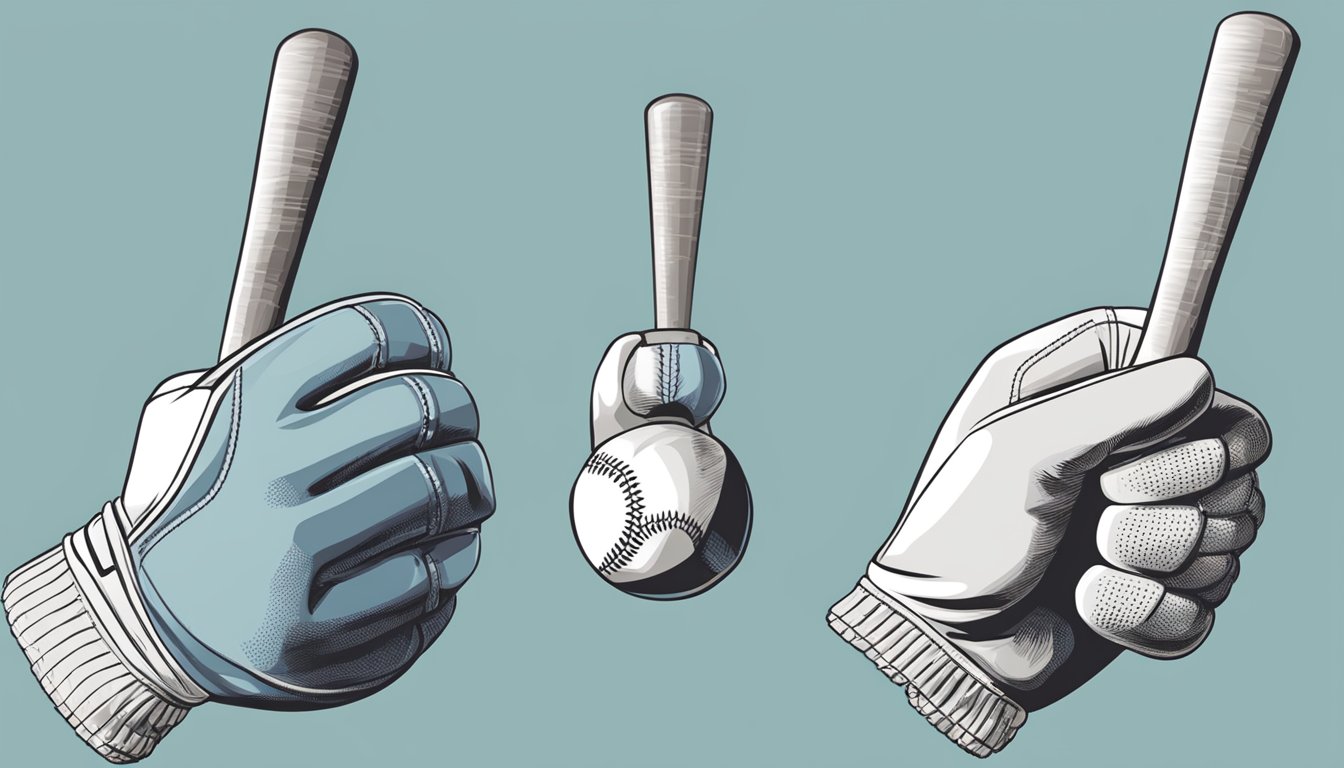In the world of competitive sports, the presence of specialized equipment that provides protection and enhances performance is a common sight. Batting gloves are a staple in baseball and cricket, serving a dual function of improving grip on the bat and mitigating hand injuries. The importance of batting gloves stretches beyond mere comfort, as they play a significant role in injury prevention for athletes.
The design of batting gloves is meticulously tailored to absorb shock, reduce vibration, and prevent blisters, all of which can hamper an athlete’s ability to perform. Additionally, these gloves help maintain a firm grip even in adverse weather conditions, thus reducing the risk of wrist and hand injuries from losing control of the bat. The intelligent choice of materials, along with ergonomic design considerations, make batting gloves an essential piece of gear for both casual and professional players.
While often underrated, the health implications of using batting gloves extend beyond the field. They can help athletes avoid long-term issues associated with repetitive stress and impact, which is particularly important for youth players who are more susceptible to injuries. Ensuring the use of proper sports equipment like batting gloves is a basic yet effective method for fostering safer sports participation.
Key Takeaways
- Batting gloves are integral for grip improvement and injury prevention.
- Material and design advancements in batting gloves contribute to protection and performance.
- Proper use of batting gloves can have positive health outcomes for athletes of all ages.
Fundamentals of Batting Gloves
https://www.youtube.com/watch?v=uemkr4gT-sw&embed=true
Batting gloves are essential accessories for players, offering numerous benefits. They provide improved grip on the bat, which is crucial for controlling swings and making precise contact with the ball. The additional layer between a player’s hands and the bat reduces the likelihood of the bat slipping due to sweat, which can accumulate during a game.
These gloves often feature padding and durable materials. The construction serves two primary purposes: enhancing comfort and mitigating the risk of blisters. With repeated use, a bat can chafe the skin, but gloves create a protective barrier. Another benefit of batting gloves is the absorption of shock upon impact with the ball. This function protects the hands from the force transmitted through the bat, potentially preventing joint and muscle injuries.
A table providing a quick summary of the roles of batting gloves:
| Function | Benefit |
|---|---|
| Improved Grip | Secure hold on bat, reduces slips |
| Sweat Absorption | Keeps hands dry, enhances control |
| Blister Prevention | Protects against chafing |
| Shock Absorption | Lessens impact force on hands |
As players’ requirements vary, batting gloves come in various designs to meet specific needs. For instance, different levels of padding may cater to those who prioritize comfort or feedback from the bat. The gloves’ materials can also differ, with some emphasizing breathability while others focus on durability.
In conclusion, batting gloves serve as a multifunctional tool in a batter’s arsenal, contributing to both performance and injury prevention. They offer a more secure grip, guard against skin damage, and can dampen the vibrations felt from striking the ball. Their use is a testament to the careful consideration players invest in their equipment to ensure peak performance.
Injury Prevention and Protection
Batting gloves serve a critical role in reducing the risk of hand injuries, mitigating the impact from collisions, and preventing overuse injuries which are common in baseball and other batting sports. Proper protective equipment is essential for player safety during physical activity.
Reducing Hand Injuries
Batting gloves provide a shield for the batter’s hands, potentially preventing blisters, cuts, and bruises which are inevitable in the absence of protection. They also offer a better grip on the bat, reducing the likelihood of the bat slipping and causing hand injuries.
Preventing Overuse Injuries
Players frequently engaging in batting can develop overuse injuries due to the repetitive nature of swinging the bat. The use of batting gloves can help in distributing stress evenly across the hands and wrists, aiding in the prevention of musculoskeletal issues, including elbow and shoulder injuries. The cushioning also helps absorb some of the shocks from repeated impact.
Mitigating Impact and Collision
Batting gloves can buoy a player’s defense against impact-related injuries like contusions. They act as a layer of protection from pitched balls or accidental collisions that might occur while at-bat or on the field. This protection is paramount as direct impacts pose significant risk factors for acute trauma to the hands and wrists.
Technique and Performance Enhancement
Batting gloves serve as more than just protective equipment; they are instrumental in refining batting technique and enhancing overall performance at the plate.
Improving Batting Technique
Proper batting technique is fundamental for a player to successfully execute at the plate. Coaches often emphasize the importance of grip, stance, and swing mechanics during training strategies. Batting gloves contribute to a more consistent and effective grip on the bat, allowing players to focus on the intricacies of their swing without distraction from discomfort or slippage. The gloves can also aid in absorbing the shock of the bat upon impact, which can help in maintaining proper technique through the following phases:
- Stance and Grip: A stable stance and proper grip are crucial. Batting gloves provide a tackier surface, improving grip stability.
- Swing Mechanics: A fluid swing is a compound movement that requires coordinated muscle contractions. Enhanced grip can contribute to a more controlled and powerful swing.
Impact of Batting Gloves on Performance
The use of batting gloves can have a direct impact on a player’s performance. While their primary role is to offer protection from injury, such as blisters and abrasions, they also play a part in performance through:
- Vibration Reduction: Gloves cushion the hands, reducing vibration and preventing muscle fatigue.
- Enhanced Control: With better grip comes increased control, allowing for more precise swings and improved running bases post-hit.
When incorporated into strength and conditioning programs, batting gloves can help players acclimate to the feel of the bat, which enhances muscle memory and technique during training sessions. Knowledgeable players and coaches recognize that incorporating batting gloves into a player’s equipment can pave the way for subtle improvements in technique, which over time, contribute to significant enhancements in batting performance.
Material and Design Considerations
Selecting the right materials and innovative design features are crucial for batting gloves to prevent injuries. They must offer comfort, improved grip, and withstand the wear from repetitive contact with the ball.
Selecting the Right Materials
Materials are pivotal in batting gloves for providing durability, comfort, and grip. High-quality leather is often the preferred choice for its longevity and ability to conform to the player’s hand. A blend of nylon can provide additional benefits:
- Nylon: Adds flexibility and warmth, essential in colder playing conditions.
- Accessories: Features such as padding and wrist straps should be made from materials that do not compromise glove integrity.
Innovations in Batting Glove Design
Design innovations aim to enhance player safety and performance. A few key design elements include:
- Palm Grip: Utilizing synthetic materials or texturing that balance grip with tactile feedback.
- Flexibility: Joint areas are designed with articulated fingers and stretch zones, reducing resistance and potential for strain.
- Breathability: Incorporating micro-perforations and mesh ensures ventilation, decreasing sweat accumulation which can lead to blisters.
Youth Engagement and Safety Measures
Youth sports programs prioritize player welfare, focusing on safety measures and injury prevention through structured coaching and adherence to sports health guidelines.
Incorporating Safety in Youth Sports
Before commencing any youth sports program, physical exams are imperative to determine a young athlete’s fitness level and identify any potential risks for shoulder injuries or other ailments. Reliable evaluation processes help in ensuring that the participants are physically ready to be engaged in sports activities.
- Physical Exam:
- Pre-participation evaluation mandated by public health authorities.
- Focus on the assessment of risks for musculoskeletal injuries.
Rules play a critical role in protecting youth athletes by prescribing appropriate safety gear such as face shields for certain sports, reducing the chances of head injuries. Clear communication of these rules and ensuring strict compliance is the responsibility of the coaches and athletic staff.
- Safety Gear:
- Emphasize the importance of proper headgear and batting gloves.
- Use of face shields in sports with high ball velocity.
Coaching and Training for Injury Reduction
Qualified coaches are crucial for effective coaching practices, which include educating youth athletes about injury prevention techniques. These professionals must be well-versed in the sport’s mechanics and safety protocols to reduce injury risks.
- Injury Prevention Techniques:
- Proper warm-up routines.
- Corrective exercises tailored to prevent shoulder injuries.
Regular training focused on these techniques, alongside the correct usage of protective equipment like batting gloves, significantly mitigates the risk of hand injuries. Coaches also need to foster an open environment for communication, where young athletes feel comfortable reporting any discomfort or injuries without the fear of negative repercussions.
- Protective Equipment:
- Batting gloves to cushion hands and absorb shocks.
- Guidelines on the maintenance and proper fit of gloves.
The intersection of youth engagement with robust safety measures, guided by informed coaching and strict public health mandates, results in a secure sporting environment that encourages the healthy development of young athletes.
Health Impact Beyond the Field
Injury prevention through the use of batting gloves extends beyond immediate protection during the game, influencing long-term health and wellness, which can have implications for both chronic disease management and psychological well-being.
Sports and Chronic Disease Management
Diabetes Management: Studies reveal that engaging in regular physical activity, such as sports participation, can play a vital role in managing Type II Diabetes. Batting gloves contribute to an athlete’s adherence to baseball, a form of physical activity that can improve blood glucose control. For individuals with diabetes, consistent, injury-free play can mean fewer complications from the disease and a better quality of life.
Public Health Knowledge: Coaches often serve as mentors and sources of knowledge, imparting the importance of sports equipment in preventing injuries. An educated coach who prioritizes player safety can foster an environment where players are more likely to engage in physical activity regularly. This, in turn, promotes overall public health by reinforcing the connection between injury prevention and long-term participation in sports.
Psychosocial Benefits of Injury Prevention
Adherence and Recreation: Injury prevention tools like batting gloves not only protect players from acute injuries but also from developing chronic conditions that might stem from these injuries. Recreational athletes who play without fear of injury are likely to continue participating in sports, which has been linked to increased self-esteem and lower levels of stress.
Sports Participation Knowledge: Reliable injury prevention contributes to an increase in sports participation. Adequate protection and the knowledge to use it properly can boost confidence in players of all ages, enabling a more enjoyable and sustained involvement in baseball. This is integral to maintaining not only physical health but also psychological well-being, greatly impacting an individual’s life beyond the diamond.
Professional Insights and Evidence
This section details professional insights and the evidence gathered from research regarding the effectiveness of batting gloves in injury prevention within team sports.
Expert Opinions on Injury Prevention
Professionals, including physiotherapists and athletic trainers, assert that wearing batting gloves can reduce the Injury Risk to hands and wrists during batting. They suggest that the gloves provide support to the joints and disperse the shock from the impact of the ball. A study analyzing a cohort of professional baseball players revealed that athletes who wore gloves had a lower Severity of Injury in their hands compared to those who did not.
- Injury Risk: Reduced by gloves providing cushioning and grip
- Severity of Injury: Mitigated through gloves’ shock absorption
Analyzing Research and Trials
Injury Epidemiology research in team sports often incorporates findings from Randomised Controlled Trials (RCTs) to offer unbiased evidence. A 2021 RCT with cricketers as subjects showed that gloves had a statistically significant role in reducing the number of hand injuries.
- Randomised Controlled Trials: Critical in reducing research Bias
- Injury Epidemiology: Points to reduced hand injuries among glove users
Future of Batting Gloves in Injury Prevention
https://www.youtube.com/watch?v=rPKBGz4ngoI&embed=true
As the sport evolves, so do the tools that protect its players. Innovations in batting gloves are progressively aiming at reducing hand and wrist injuries, specifically considering the needs at various levels of play.
Materials and Technology: The future likely holds advanced materials with better shock absorption and durability. These materials will be engineered to dissipate the energy from high-speed pitches, thereby offering better protection for the wearer and potentially reducing the risk of injuries such as fractures or damage to the Ulnar Collateral Ligament (UCL).
Customization and Fit: A customized fit can enhance control and reduce slippage, lessening the chance of strain. Manufacturers may use smart fabrics and 3D printing technology to create personalized gloves that adapt to the individual anatomy of a professional player’s hand.
Protection for Pitchers: While typically not associated with pitchers, batting gloves might be redesigned to cater to their specific needs as well. This subset of players can benefit from gloves that protect the hands when batting, as any injury could directly impact their ability to pitch.
Research and Development (R&D): Investment in R&D will likely generate data-driven designs. This approach could see an increase in gloves that incorporate padding and support in high-stress areas. Companies may collaborate with sports medicine experts to create products that address common chronic issues faced by athletes.
Intersection with Wearable Tech: There is potential for batting gloves to integrate with wearable technology, offering real-time data that could help athletes adjust their grip or swing to avoid undue stress on their hands and arms.
By leaning on scientific advancements and feedback from professionals, manufacturers are poised to elevate the safety provided by batting gloves. This focus on injury prevention is expected to adapt to the demands of the game, ensuring players can deliver optimum performance with reduced risk.
Frequently Asked Questions
https://www.youtube.com/watch?v=ZIz_eBtxDy0&embed=true
Batting gloves are essential equipment in baseball and cricket, providing grip and reducing the risk of hand injuries. This section addresses common inquiries regarding their protective qualities and proper use.
How do batting gloves help prevent hand injuries during play?
Batting gloves cushion the hands, absorb shock from the bat’s impact with the ball, and minimize vibration. They also protect the skin from the wear and tear of repeated swings, helping to prevent blisters and calluses.
What material considerations are important for batting gloves to provide protection?
The glove material must be durable, flexible, and offer enough padding. Leather gloves are often preferred for their durability and comfort, while synthetic materials can provide additional flexibility and moisture-wicking properties.
Can wearing batting gloves impact the grip and bat control, thus reducing the chance of injury?
Yes, batting gloves improve the player’s grip on the bat, which can lead to better control and precision while swinging. This enhances performance and minimizes the likelihood of a bat slipping, which may lead to accidents.
What maintenance practices extend the life and protective function of batting gloves?
Proper maintenance includes cleaning gloves to remove dirt and sweat and storing them in a cool, dry place. Regularly inspect for signs of wear and tear, such as thinning or stitching coming undone, and replace if necessary.
What differences exist between youth and adult batting gloves in terms of injury prevention?
Youth batting gloves typically have more padding and are designed for a more snug fit to compensate for children’s developing muscles and bones, which may be more susceptible to injury from impact.
How does the padding and fit of a batting glove contribute to reducing the risk of blisters and other hand injuries?
Padding in key areas like the palm and fingers helps absorb impact, while a snug fit prevents excess material from bunching up and causing friction, which can lead to blisters and abrasions during play.














